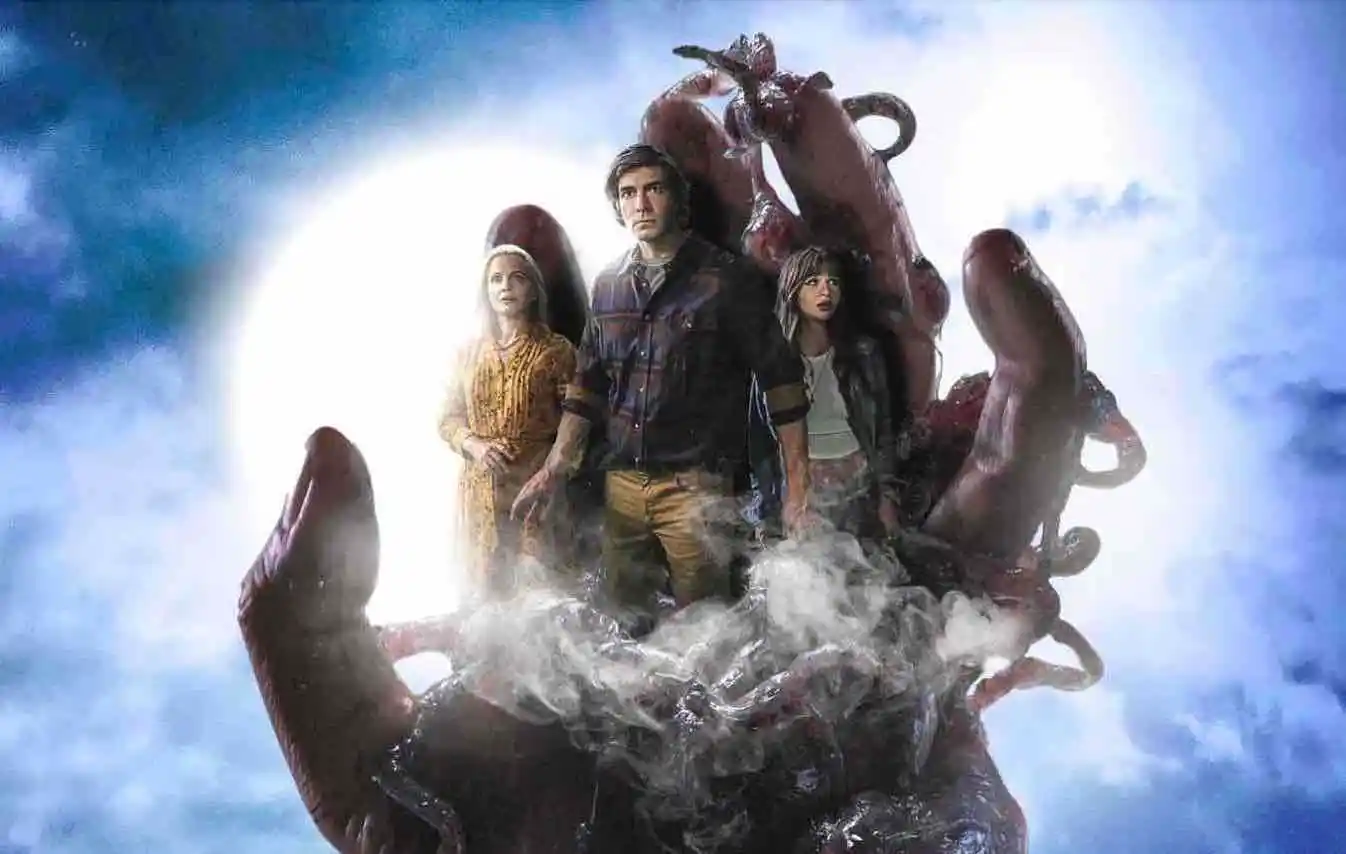Reviews
‘Ick’ Review: Near-Perfect Sci-fi Horror is EMO AS F#%@!

Remember the 2000s? Remember how great they were? Wall Street, the war on terror, freedom fries, balloon boy…uhh, scratch that, remember 2000s movies??? The decade was filled with high-school-set, pop-punk scored, heartfelt, and hilarious fun on the big screen. No matter the genre, never was an era’s films more steeped in the aesthetics of its own decade, breathing in the wafting clouds of hairspray, letting eyes sag under the weight of Gerard Way’s eyeliner brand, and pulling up the latest bangers on an original iPod. While modern movies set during the 2000s have tried to capture the era through occasional needle drops or casual references that elicit a light chuckle, Joseph Kahn’s Ick truly understands what makes 2000s movies tick in a way that other nostalgia-fests don’t.
Ick follows Hank (Brandon Routh), a dorky, depressed High School science teacher who never left his hometown after a sporting accident left him unable to play Football in college. An ex-quarterback and ex-Prom King, one who lost the love of his life to his best friend, his life is spent living the glory days of the 2000s. But as a thought-to-be docile, terrifying alien substance begins to take over the town, he begins to suspect that his student Grace (Maline Weisman) might actually be his Daughter. Turns out, he might just finally have something to fight for. Hilarious, visceral, and heartfelt, with a killer pop-punk soundtrack perfect for Warped Tour, Ick is a feel-good horror-comedy throwback to emo cinema —and perhaps the most effective creature feature in years.
Ick Does Nostalgia Right
We live in an era of nostalgia. 80s nostalgia has dominated media for some time, and our collective brains are beginning to reflect on the 90s and 2000s. Ick works not because it’s a nostalgia vehicle, but in spite of it. The movie does not simply reflect on the surface-level aesthetics and visuals of the time period, but truly understands what makes a great 2000s High School movie.
The film has a genuine, heartfelt nature rarely seen in movies today, with a sense of humor straight from the time period and setting. Hank is a true underdog protagonist, and his journey is an optimistic and relatable one. While the ending (slight spoilers) may not completely resolve the threats at hand, it remains hopeful. As will be discussed later, nostalgia also works as one of the most important metaphors of the year.
Additionally, Brandon Routh is at his best in this leading role. He is so damn charming, every second he is on screen is a dorky delight. The supporting cast is also great at portraying a likable high school class, simultaneously grounded in realistic archetypes and problems, but heightened in some ways for comedic value.
The comedy is an absolute blast. By far the funniest movie of the year, the jokes only rarely miss. Kahn’s dynamic and fast-paced timing work perfectly in this witty, satirical comedy. Some of the millennial jokes going after Gen Z’s dialect can get a little bit old, but it never goes far enough to elicit a full groan, but maybe just the occasional eye roll from a younger viewer. This millennial-at-heart could not stop smiling for a second of the runtime, though.
Now, let’s get to the horror.

Image via Interstellar Entertainment
A Dynamic, Suspenseful Creature Feature
It’s been a while since we’ve gotten a truly great creature feature. Wolf Man was fun, and Sinners is the most talked about movie, horror or otherwise, of the year, but vampires and werewolves are sort of genres unto themselves. Ick truly understands how to make an original monster, even if one could hope for an even bloodier edit.
The Ick itself is pretty damn creepy. It works similarly to the 2008 movie Splinter, the creature is a plant-like substance that grows and overtakes everything in its path like the Blob, but expands into either goopy, fluid tentacles, or tree-branch-like appendages. It’s pretty damn gross. Additionally, this is combined with the brain-controlling powers of Invasion of the Body Snatchers, where the titular being can also zombify townspeople into cult-like, hive-minded worshippers. The movie has fun playing with numerous sci-fi horror tropes, blending The Faculty with The Blob, and perhaps a touch of Cronenberg for good measure.
The gore and kills are also great! Director Joseph Kahn has a lot of fun tearing people apart from the inside, having people eaten alive, burned, frozen, and bashed. No one killed the same way twice, and it is the perfect kind of alien mayhem cinema has been missing. However, it could still go that extra step. The movie is rated R, and it does not feel quite earned-just a little bit more practical blood and guts, and we would have total splatter nastiness. However, considering the heartfelt nature of the movie, this might be tonally for the best.
Dynamic Filmmaking

Picture above: The All American Rejects
A KILLER Soundtrack
When Fathom Events started its screening with a recorded intro from the Director, alongside some words from Tyson Ritter, frontman of All-American Rejects, you know the soundtrack is gonna be killer. As promised by the marketing, the soundtrack is perfect, and emo as HELL. All-American Rejects, Creed, Paramore, Blink-182…it is a scene kids’ dream movie soundtrack, and might even give Jennifer’s Body an emo run for its money.
The needle drops are over-the-top, and wildly over-dramatic, but would we really want it any other way? Ick promises a 2000s alternative soundtrack, and it does not disappoint. How can you possibly complain when the film’s all-is-lost moment is set to Hey, Delilah?
Monstrous Metaphors
Considering the movie is mostly set in the 2020s, with the main protagonist longing for the days when Blink-182 was associated with frat guys rather than emo kids, the movie utilizes its nostalgia as a metaphor for hope. We live in cynical times. The “Ick” in this movie can be a stand-in for any number of current worries. Nuclear war, COVID, political tension, McCarthyist era paranoia…the list goes on.
However, the Ick’s greatest threats are the characters’ working together, forming bonds, finding love, and, ultimately, rediscovering hope. Optimism. Again, the movie is not set in the 2000s, but purposefully lets that decade’s optimism seep into our time. Maybe, just maybe, hope is not something from a bygone era to be nostalgic for—it’s something we can still find in our current day, regardless of which bands are together and which have broken up.
So, is Ick the most important movie of our current day, then? Probably not. It’s far from perfect, but it might be exactly what we need as a society right now. It is a skin-crawling, feel-good horror movie that reminds us that maybe with the right people, the right motivations, and the right music, everything might just be okay.
Check out Ick in theaters now for a limited time through Fathom Events. Its more than worth the watch!
SOURCE: The Wrap, Drew Taylor, ‘Ick’ Director Joseph Kahn Is Tired of Being Head of the Curve
Reviews
‘Frankenstein’ Review: Guillermo Del Toro Is Off to the Races

Those expecting Guillermo Del Toro’s Frankenstein to be similar to the book, or to any other adaptation, are in for something else. A longtime enjoyer of the creature’s story, Del Toro instead draws from many places: the novel, James Whale’s culturally defining 1931 film, the Kenneth Branagh version, there are even hints from Terence Fisher’s Curse of Frankenstein, and if the set design and costuming are to be believed, there are trace elements of the National Theatre production too.
The formulation to breathe life into this amalgam is a sort of storm cloud of cultural memory and personal desire for Del Toro. This is about crafting his Frankenstein: the one he wanted to see since he was young, the vision he wanted to stitch together. What results is an experience that is more colorful and kinetic and well-loved by its creator than any Frankenstein we’ve had yet, but what it leaves behind is much of its gothic heart. Quiet darkness, looming dread, poetry, and romance are set aside as what has been sold as “the definitive retelling” goes off to the races. It’s a fast-paced ride through a world of mad science, and you’re on it.
Victor Frankenstein’s Ambition and Tragedy
A tale as old as time, with some changes: the morbid talents and untamed hubris of Victor Frankenstein (Oscar Isaac) guide him to challenge death itself. Spurred by a wealthy investor named Henrich Harlander, and a desire for Harlander’s niece Elizabeth (Mia Goth), Victor uses dead flesh and voltaic vigor to bring a creature to life. His attempts to rear it, however, go horribly wrong, setting the two on a bloody collision course as the definitions of man and monster become blurred.
Guillermo Del Toro’s Frankenstein is more Hellboy in its presentation than it is Crimson Peak; it’s honestly more similar to Coppola’s Dracula than either of them. The film is barely done with its opening when it starts with a loud sequence of the monster attacking Walton’s ship on the ice. Flinging crew members about and walking against volleys of gunfire, he is a monstrosity by no other name. The Creature (Jacob Elordi) cries out in guttural screams, part animal and part man, as it calls for its creator to be returned to him. While visually impressive (and it remains visually impressive throughout, believe me), this appropriately bombastic hook foreshadows a problem with tone and tempo.
A Monster That Moves Too Fast
The pace overall is far too fast for its first half, even with its heavy two-and-a-half-hour runtime. It’s also a far cry from the brooding nature the story usually takes. A scene where Victor demonstrates rudimentary reanimation to his peers and a council of judges is rapid, where it should be agonizingly slow. There’s horror and an instability in Victor to be emphasized in that moment, but the grotesque sight is an oddly triumphant one instead. Most do not revile his experiments; in fact he’s taken quite seriously.
Many scenes like this create a tonal problem that makes Victor’s tale lean more toward melodrama than toward philosophical or emotional aspects; he is blatantly wild and free, in a way that is respected rather than pitied. There are opportunities to stop, breathe in the Victorian roses and the smell of death, to get really dour, but it’s neglected until the film’s second half.
Isaac’s and Goth’s performances are overwrought at points, feeling more like pantomimes of Byronic characters. I’m not entirely convinced it has more to do with them than with the script they’re given. Like Victor working with the parts of inmates and dead soldiers, even the best of actors with the best of on-screen chemistry are forced to make do. The dialogue has incredibly high highs (especially in its final moments), but when it has lows, how low they are; a character outright stating that “Victor is the real monster” adage to his face was an ocean floor piece of writing if there ever was one.
Isaac, Goth, and Elordi Bring Life to the Dead
Jacob Elordi’s work here, however, is blameless. Though Elordi’s physical performance as the creature will surely win praise, his time speaking is the true highlight. It’s almost certainly a definitive portrayal of the character; his voice for Victor’s creation is haunted with scorn and solitude, the same way his flesh is haunted by the marks of his creator’s handiwork. It agonizes me to see so little of the books’ most iconic lines used wholesale here, because they would be absolutely perfect coming from Elordi. Still, he has incredible chemistry with both Isaac and Goth, and for as brief as their time together is, he radiates pure force.
Frankenstein Is a Masterclass in Mise-En-Scène
Despite its pacing and tone issues, one can’t help but appreciate the truly masterful craftsmanship Del Toro has managed to pack into the screen. Every millimeter of the sets is carved to specification, filled with personality through to the shadows. Every piece of brick, hint of frost, stain of blood, and curve of the vine is painstakingly and surgically placed to create one of the most wonderful and spellbinding sets you’ve seen—and then it keeps presenting you with new environments like that, over, and over.
At the very least, Del Toro’s Frankenstein is a masterpiece of mise-en-scène down to the minutest of details, and that makes it endlessly rewatchable for aesthetic purposes. This isn’t even getting into the effervescent lighting, or how returning collaborator Kate Hawley has outdone herself again with the costuming. Guillermo Del Toro tackling the king of gothic horror stories, a story written by the mother of all science fiction, inevitably set a high bar for him to clear. And while it’s not a pitch perfect rendering of Mary Shelley’s slow moving and Shakespearean epistolary, it is still one of the best-looking movies you will see all year.
Perhaps for us, it’s at the cost of adapting the straightforward, dark story we know into something more operatic. It sings the tale like a soprano rather than reciting it like humble prose, and it doesn’t always sing well. But for Del Toro, the epic scale and voice of this adaptation is the wage expected for making the movie he’s always dreamed of. Even with its problems, it’s well worth it to see a visionary director at work on a story they love.
Reviews
‘The Siege of Ape Canyon’ Review: Bigfoot Comes Home

In my home, films like Night of the Demon and Abominable are played on repeat; Stan Gordon is king. One of my favorite stories surrounding Bigfoot and Ufology is the Bigfoot/UFO double flap of 1973, which Stan Gordon has an incredible in-depth book on. The Patterson–Gimlin film couldn’t hold a flame to Stan Gordon’s dive into one of my home state’s most chronicled supernatural time periods. But as much as I love the Bigfoot topic, I’m not ashamed to say I don’t know half of the stories surrounding that big hairy beast. And one topic that I’m not ashamed to say I haven’t heard of is The Siege of Ape Canyon.
The Harrowing Events of Ape Canyon
Washington State, 1924. A group of miners (originally consisting of Marion Smith, Leroy P. Smith, Fred Beck, John Peterson, August Johannson, and Mac Rhodes) was on a quest to claim a potential gold mine. Literally. The miners would eventually set up camp on the east slope of Mount Saint Helens. Little did they know their temporary shelter would be the start of a multi-day barrage of attacks from what they and researchers believed to be Bigfoot. What transpired in those days would turn out to be one of the most highly criticized pieces of American lore, nearly lost to time and history…nearly.
I need to set the record straight on a few things before we get started. One, I don’t typically like watching documentaries. Two, I believe in Bigfoot. Three, this documentary made me cry.

Image courtesy of Justin Cook Public Relations.
Reviving a Forgotten Bigfoot Legend in The Siege of Ape Canyon
Documentarian Eli Watson sets out to tell one of the most prolific Bigfoot stories of all time (for those who are deep in Bigfoot mythology). It’s noted fairly early in the film that this story is told often and is well known in the Washington area. So then, how do people outside of the incident location know so little about it? I’ve read at least 15 books on and about Bigfoot, and I’ve never once heard this story. This isn’t a Stan-Gordon-reported story about someone sitting on the john and seeing a pair of red eyes outside of their bathroom window. The story around Ape Canyon has a deeper spiritual meaning that goes beyond a few sightings here and there.
Watson’s documentary, though, isn’t just about Bigfoot or unearthing the story of Ape Canyon. Ape Canyon nearly became nothing more than a tall tale that elders would share around a campfire to keep the younglings out of the woods at 2 AM. If it weren’t for Mark Myrsell, that’s exactly what would have happened. The Siege of Ape Canyon spends half its time unpacking the story of Fred Beck and his prospecting crew, and the other half tells a truly inspiring tale of unbridled passion, friendship, and love.
Mark Myrsell’s Relentless Pursuit: Friendship, Truth, and Tears
Mark Myrsell’s undying passion for everything outdoors inevitably led to bringing one of Bigfoot’s craziest stories to light. His devotion to the truth vindicated many people who were (probably) labeled kooks and crazies. Throughout Myrsell’s endless search for the truth, he made lifelong friends along the way. What brought me to tears throughout The Siege of Ape Canyon is Watson’s insistence on showing the human side of Myrsell and his friends. They’re not in this to make millions or bag a Bigfoot corpse; they just want to know the truth. And that’s what they find.
The Siege of Ape Canyon is a documentary that will open your eyes to a wildly mystical story you may not have heard of. And it does it pretty damn well. Whereas many documentaries feel the need to talk down to the viewer just to educate them, Watson’s documentary takes you along for the ride. It doesn’t ask you to believe or not believe in Bigfoot. It allows you to make your own decisions and provides the evidence it needs to. If you’ve ever had a passing interest in the topic of Bigfoot, or if you think you’re the next Stan Gordon, I highly recommend watching The Siege of Ape Canyon.
The Siege of Ape Canyon stomps its way onto digital platforms on November 11. Give yourself a little post-Halloween treat and check it out!






















